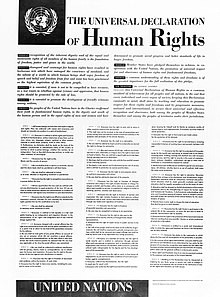Deklarasi Universal Hak Asasi Manusia
| Universal Declaration of Human Rights | |
|---|---|
 Eleanor Roosevelt holding the English language version of the Universal Declaration of Human Rights. | |
 The human rights adopted by the United Nations General Assembly of its 183rd meeting, held in Paris on 10 December 1948 | |
| Disusun | 1948 |
| Diratifikasi | 10 December 1948 |
| Tampek | Palais de Chaillot, Paris |
| Panyusun | Draft Committee[lower-alpha 1] |
| Tujuan | Human rights |
| Ado naskah sumber nan bakaitan jo |
The Universal Declaration of Human Rights (UDHR) is an international document adopted by the United Nations General Assembly that enshrines the rights and freedoms of all human beings. It was accepted by the General Assembly as Resolution 217 during its third session on 10 December 1948 at the Palais de Chaillot in Paris, France.[1] Of the 58 members of the United Nations at the time, 48 voted in favour, none against, eight abstained, and two did not vote.[2]
Considered a foundational text in the history of human and civil rights, the Declaration consists of 30 articles detailing an individual's "basic rights and fundamental freedoms" and affirming their universal character as inherent, inalienable, and applicable to all human beings.[1] Adopted as a "common standard of achievement for all peoples and all nations", the UDHR commits nations to recognize all humans as being "born free and equal in dignity and rights" regardless of "nationality, place of residence, gender, national or ethnic origin, colour, religion, language, or any other status".[3] The Declaration is considered a "milestone document" for its "universalist language", which makes no reference to a particular culture, political system, or religion.[4][5] It directly inspired the development of international human rights law, and was the first step in the formulation of the International Bill of Human Rights, which was completed in 1966 and came into force in 1976.
Although not legally binding, the contents of the UDHR have been elaborated and incorporated into subsequent international treaties, regional human rights instruments, and national constitutions and legal codes.[1] All 193 member states of the United Nations have ratified at least one of the nine binding treaties influenced by the Declaration, with the vast majority ratifying four or more.[1] Some legal scholars have argued that because countries have consistently invoked the Declaration for more than 50 years, it has become binding as part of customary international law,[6][7] although courts in some nations have been more restrictive on its legal effect.[8][9] Nevertheless, the UDHR has influenced legal, political, and social developments on both the global and national levels, with its significance partly evidenced by its 524 translations, the most of any document in history.[10]
Rujuakan
- ↑ a b c d "Human Rights Law". www.un.org (dalam bahasa Inggris). 2015-09-02. Diakses tanggal 2020-08-20.
- ↑ "A/RES/217(III)". UNBISNET. Diarsipkan dari versi asli tanggal 21 January 2019. Diakses tanggal 24 May 2015.
- ↑ UDHR Booklet, Art. 2.
- ↑ "Universal Declaration of Human Rights". www.amnesty.org (dalam bahasa Inggris). Diakses tanggal 2020-08-20.
- ↑ "Human Rights: The Universal Declaration vs The Cairo Declaration". Middle East Centre. 2012-12-10. Diakses tanggal 2020-08-20.
- ↑ Henry J Steiner and Philip Alston, International Human Rights in Context: Law, Politics, Morals, (2nd ed), Oxford University Press, Oxford, 2000.
- ↑ Hurst Hannum, The universal declaration of human rights in National and International Law, p.145
- ↑ Posner, Eric (2014-12-04). "The case against human rights | Eric Posner". The Guardian (dalam bahasa Inggris). ISSN 0261-3077. Diakses tanggal 2020-01-22.
- ↑ Sosa v. Alvarez-Machain, 542 U.S. 692, 734 (2004).
- ↑ "OHCHR | Universal Declaration of Human Rights Main". www.ohchr.org. Diakses tanggal 2020-08-20.
Kutipan rusak: Tag <ref> ado untuak grup banamo "lower-alpha", tapi indak ado <references group="lower-alpha"/>
